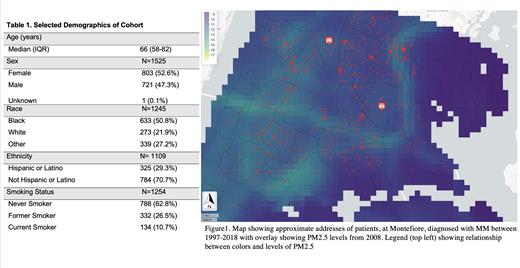Introduction
Outdoor air pollution (OAP) is a complex mixture, primarily consisting of black carbon (BC), nitrogen dioxide (NO2), sulfur dioxide (SO2), ozone (O3), and particulate matter with an aerodynamic diameter of less than 2.5 microns (PM2.5). OAP is typically generated by the combustion process from motor vehicles, fossil fuel burning and industrial waste. The potential impact of air pollutants on cancer outcomes has not been systematically studied in communities of color.
Multiple Myeloma (MM) is a hematologic malignancy defined by the clonal expansion of plasma cells leading to subsequent monoclonal protein expression resulting in multiple complications including anemia, renal disease, significant bone pain and increased fracture risk. MM is the second most common hematologic malignancy. The US Surveillance, Epidemiology, and End Results (SEER) registry estimates 34,000 new cases diagnosed and 13,000 deaths annually from MM. Risk factors for multiple myeloma include race, BMI, and occasionally genetic predisposition. Blacks and Hispanics were shown to have a higher incidence of MM that of non-Hispanic whites (Kaur G et al Clin Lymphoma Myeloma Leuk. 2021).
There is recent evidence to suggest that environmental exposures, OAP in particular, may play a role in propagating disease progression in multiple myeloma (Landgren O JAMA Oncol 2015). A recent study demonstrated that first responders to the World Trade Center disaster had a higher rate of developing myeloma precursor disease (MGUS) and an earlier age of developing multiple myeloma (Landgren O JAMA Oncol. 2018). Our study seeks to further characterize patterns of exposure to OAP in patients with MM.
Methods
A retrospective cohort was developed of patients diagnosed with Multiple Myeloma at Montefiore Health System (Bronx, NY) between 1997-2018 (n=1608), using the Montefiore Electronic Data Warehouse. Of those patients, 1525 were identified as having 1 st cancer diagnosis of MM. Patient addresses (n=1514) were then used to geospatially overlay with OAP and Organic Matter from 2000-2018 using land use regression models. Ground-level PM2.5 was estimated by combining Aerosol Optical Depth (AOD) retrievals from the NASA MODIS, MISR, and SeaWIFS instruments with the GEOS-Chem chemical transport model, and subsequently calibrated to regional ground-based observations of both total and compositional mass using Geographically Weighted Regression (Hammer M.S et al Environ. Sci. Technol. 2020). This initial analysis focuses specifically on PM2.5, which was summarized as the number of years each patient was exposed to levels higher than the EPA standard of 12ug/m 3 and if the patient experienced an average PM2.5 >12ug/m 3 across their entire follow-up in the cohort. Additional information regarding demographics, dates of diagnosis and certain clinical parameters (Hgb, Cr, albumin, etc) were extracted. Differences in PM2.5 exposures, and clinical parameters, were compared by race and ethnicity using t-tests and chi-squared tests. Cox proportional hazards regression estimated the risk of death during follow-up associated with PM2.5 exposure, adjusting for confounders.
Results
Our patient population was highly diverse. Patients were 21% White, 50% Black with 27% having Race classified as Other. Thirty percent were Hispanic. Age at mean diagnosis was 66.24 years. On average, Bronx MM patients had higher exposure to PM2.5 than the EPA safe standard of 12 µg/m 3 from years 2000-2007 and the WHO safe standard of 5 µg/m 3 in all years of follow-up. Improved overall survival among our Multiple Myeloma patients was associated with fewer number of years exposed to PM2.5 >12 µg/m 3 (Hazard Ratio (HR)=1.12, 95% Confidence Interval (CI)=0.99- 1.27), when adjusting for sex and race. Further adjustment for smoking status yielded similar results (HR = 1.13, 95%CI = 0.98-1.30).
Conclusion
In this large urban, multi-ethnic cohort of MM patients, many patients experienced annual exposures to PM2.5 that were higher than the EPA and WHO safe standards of 12 µg/m 3 and 5 µg/m 3. Overall survival in MM patients was associated with fewer years of exposure to PM2.5, suggesting that reducing exposure to environmental pollutants, particularly OAP for our patients may lead to better outcomes. Additional analyses are needed to better understand the impact of treatment and clinical factors, as well as the other air pollutants in this patient population.
Disclosures
Shastri:Rigel Pharmaceuticals: Honoraria; Gilead Sciences: Honoraria; Kymera Therapeutics: Honoraria, Research Funding; Janssen Pharmaceuticals, Inc.: Consultancy, Honoraria.


This feature is available to Subscribers Only
Sign In or Create an Account Close Modal